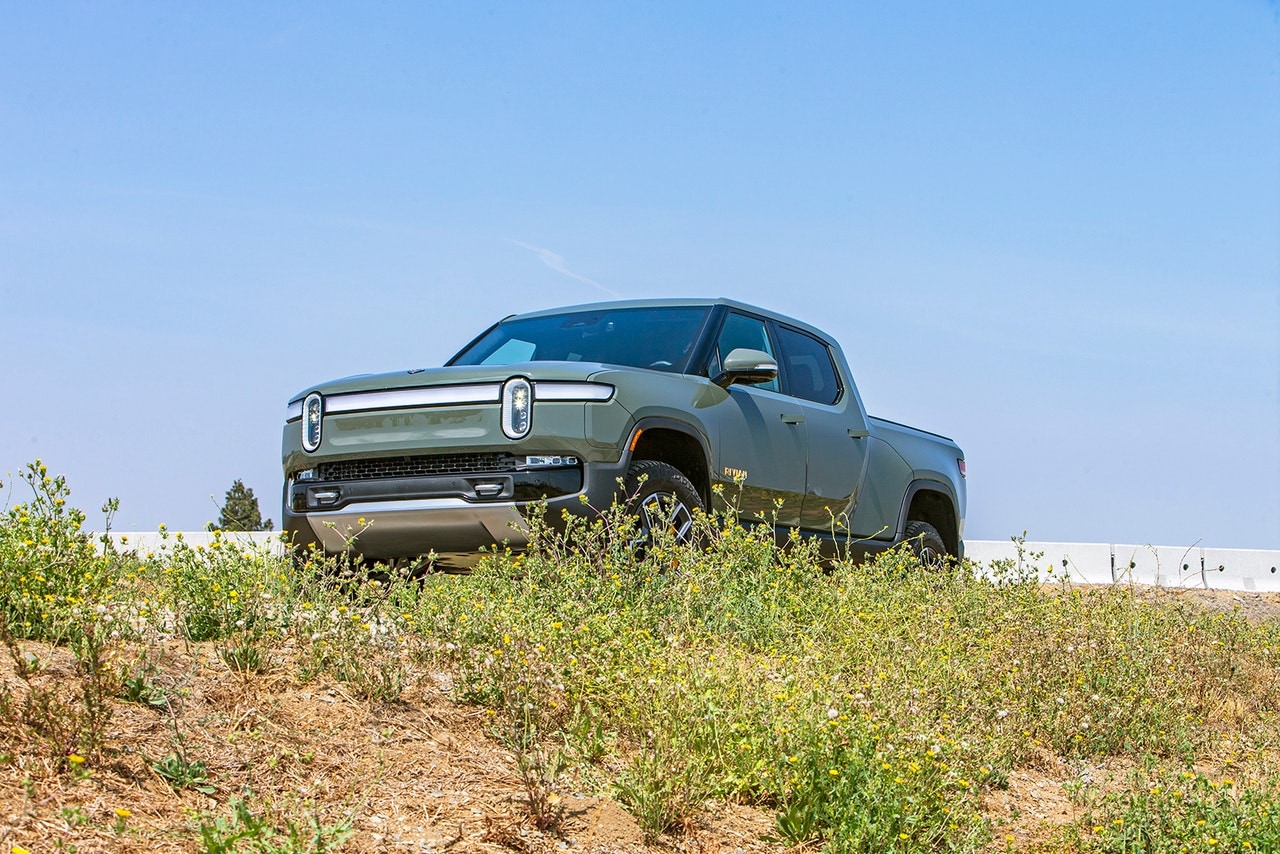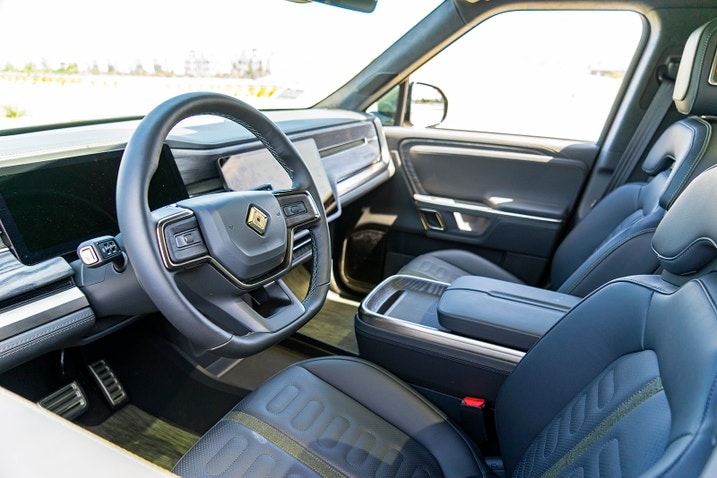- Our Rivian R1T ground to a halt on the way to work.
- Luckily, traffic was moving at a snail's pace.
- Eventually, after much fiddling, we found a way to start it back up and get on with our morning.
- After our story published, Rivian reached out and told us its data suggested we had inadvertently placed the transmission into neutral.
UPDATED: Our Long-Term Rivian R1T Stopped Working on the Freeway
After much fiddling, we were back on the road
Update 10/5/2022: We followed up with Rivian with a number of questions on how the adaptive cruise control works and how this situation arose. We have included the entire correspondence between ourselves and a Rivian spokesperson below.
Question 1: Broadly, how does the adaptive cruise control/transmission selector stalk work? Our driver reported that they were trying to alter the cruise control speed when the car began slowing to a stop. According to the data you shared with [us], this was because our driver had engaged Neutral.
Rivian's response: Changing cruise control speed is done through the steering wheel buttons and not through the stalks. The move to Neutral happened 51 seconds after the driver disengaged ACC by pressing the brakes.
Question 2: How did our driver shift into Neutral in the first place — doesn't the function of the stalk change to ACC operation while the car is moving?
Rivian's response: The driver exited ACC with the brake pedal. After exiting ACC, the driver engaged Neutral by moving the stalk up, and holding the stalk for 200 ms [0.2 second].
Question 3: Or is there some sort of action that we performed that changed the operation of this lever from ACC to transmission select, and if so, what is this action?
Rivian's response: The driver was initially in ACC, as indicated by the UI [user interface]. The driver then pressed the brakes to exit ACC. The ACC blue circle disappeared, and the vehicle emitted an audible chime to inform the driver. 51 seconds after that, the driver engaged Neutral by moving the stalk up, and holding the stalk for 200 ms [0.2 second].
Question 4: Is there any obvious warning that we could have overlooked that shows the vehicle has shifted into Neutral?
Rivian's response: Per above description, multiple audible and visual indicators were given to the driver. The disengagement from ACC resulted in an audible chime and a change in ACC icon. The move to Neutral was only possible after moving the stalk up and holding it for 200 ms [0.2 second]. This is to protect against incidental [sic] activation of Neutral. The PRNDL indication turned from D to N.
Question 5: Also, we mentioned during your conversation on Friday that you were preparing some sort of statement that we could include in an update to the story? If so, could you provide us with that?
Rivian's response: The vehicle data shows that this was a user error and the vehicle behaved as intended by providing both audio and visual indicators to the driver. During the development of our vehicles, Rivian conducted multiple iterations of testing and user feedback, and we added conditions such as holding stalks to protect against any incidental [sic] changes to drive status. This is the first report of such an incident, and we will look into whether we can make any further improvements to protect from system misuse.
The above was a conversation that took place between our editorial team and Rivian's spokesperson on Monday. While we understand the cause may have been user error, our driver reported never hearing the chime Rivian claims the car made. Furthermore, what really stands out is just how little time it took for that error to occur. Rivian's spokesperson notes the stalk was pressed for 200 milliseconds, or two-tenths of a second. For context, the blink of an eye typically takes 300 milliseconds. That means our "user error" lasted less than the blink of an eye, and the car still shifted into neutral. We think this is potentially something Rivian can learn from, as accidental presses like this (especially for such an exceptionally short duration) can happen to anyone. We urge Rivian to take a closer look at its software and potentially roll out an over-the-air update to try to mitigate the possibility of this happening to others.
Update 1: After publishing this story, Rivian's software engineers contacted us and told us their data showed the truck was accidentally shifted into neutral. This occurred while the driver was attempting to activate the truck's adaptive cruise control (ACC) functions. The ACC controls utilize the same stalk on the right side of the steering column that also serves as the gear selector. Tapping down on the stalk activates adaptive cruise, but tapping up momentarily instead shifts the car into neutral. Our accidental switch to neutral caused a loss of drive.
The R1T showed no warning lights and made no clear indication to our driver that it was shifted into neutral. This led us to believe that the Rivian had failed in some way, and that is what we reported. An updated version of the original story, found below, is an honest account of the situation as it appeared to the members of our editorial staff at the time.
This incident illustrates an area of opportunity for manufacturers to identify potential errors and alert the driver. Traveling at freeway speeds and shifting into neutral is unlikely to be triggered intentionally, and could have sounded an obtrusive alert. This action, combined with our request for acceleration, is an even more uncommon sequence of events and also could have sounded an alert. This is particularly pertinent to EVs, which have neither a rev counter nor engine noise to help the driver identify the problem.
Update 2: After Rivian told us that the slip into neutral was driver error, we got back behind the wheel to see if we could re-create the issue. After experimenting with the stalk while driving — and updating the R1T's software to the newest version (the initial freeway drive was with a previous version) — senior editor Ryan ZumMallen reported the following:
If you:
Press hard up on the stalk while driving it will issue warning to hold the stalk for 4 seconds in order to shift Press hard up and hold the stalk while driving it will issue a warning to slow down in order to shift Press light up on the stalk while driving it will issue the same warnings Press light up on the stalk AND HOLD while driving it will shift the car into neutral with no warning and no message
Once you are in neutral while moving and coasting to a stop, if you:
Press the accelerator, nothing will happen Press the accelerator and press down on the stalk to shift into drive, it will issue a warning to stop accelerating Press down lightly on the stalk to shift into drive, it will issue a warning to come to a stop to enter drive Press hard down on the stalk to shift into drive, it will shift into drive and you can accelerate again
Ryan even shot a couple of videos in which we were able to shift the vehicle into neutral and not trigger any obvious warning, which is what we believe happened on our initial freeway drive.
Am I Ready for an EV?
- EV ownership works best if you can charge at home (240V outlet) This typically means a 240V home installation, or other places your car is parked for several hours each day. Don't expect a regular household outlet (120V) to suffice.
- Adding a home charging system is estimated to cost $1,616 in This is an estimate for your area. Using your address and the answers you provide, Treehouse can provide a more accurate price.
- Edmunds is partnering with Treehouse, an independent provider of home EV installation services. Learn more Edmunds customers receive a 10% installation discount and 4% smart charger discount. Discount excludes permit, hosted inspection, and load management devices. Valid for 30 days.
We have reached out to Rivian to understand how the stalk is intended to operate, because we're not satisfied that this was a simple case of driver error. We will update this story when we hear back.
Los Angeles is known for a number of things, and not all of them are great. One case in point? Traffic everywhere, all of the time. That already makes the commute to work one heck of an ordeal, but for two of our staffers yesterday, it got even worse when our Rivian R1T (part of Edmunds' long-term test fleet) decided it just couldn't deal with the slog anymore.
A normal weekday for most of our staff here at Edmunds involves wading through stop-and-go on the infamous 405 freeway. Normally, it's just that. But on Wednesday, two members of our editorial team had a bit more to contend with. Our staffer who was at the wheel of the R1T experienced a sudden loss of power. Repeated jabs at the throttle pedal did nothing, and eventually the R1T ground to a halt.
The dashboard of the Rivian revealed no warning lights and the infotainment screen was still working as the truck came to a stop in the middle of the freeway. After just a few seconds, impatient Angelenos were infuriated, whizzing past and giving the classic single-finger hello. It's worth noting the Rivian doesn't have a start/stop button, so there isn't an obvious way to turn it off and back on. This makes it especially difficult for our staffers, who are constantly switching into new vehicles. There's also the complication of the R1T's reset process — you don't simply turn it off and back on again.
After a little brainstorming, the R1T's occupants decided to try every trick in the book. They put the R1T into park, locked and unlocked the car, and opened and closed the doors (in rush-hour traffic) to get the Rivian to come back to life. It worked. After all that they were able to put the truck into drive and rejoin the gauntlet. It was as if nothing happened, and the lack of warning lights or alerts from the car throughout the ordeal indicated that the R1T didn't think anything was wrong either. We think this comes down to a small bug that can result in a major hassle, and while we know EVs from startups can be pesky, buyers of a brand-new $80,000 vehicle really shouldn't worry about this type of problem.
We've reached out to Rivian to see if it can decipher what happened to the R1T, and we'll update our long-term test log once we hear back. Until then, if your Rivian comes to a mysterious dead stop in the heat of midmorning traffic, at least you know you're not the only one it's happened to.
Edmunds maintains a fleet of vehicles for long-term testing, where editors drive and report the ownership experience of a number of new cars, SUVs, pickup trucks and EVs over at least 12 months/20,000 miles.
Edmunds says
Our Rivian deciding to take a nap in the middle of the 405 is not at all how we wanted to start hump day.







 by
by